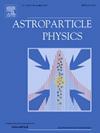反氦-3在GRAMS实验中的灵敏度
IF 2.9
3区 物理与天体物理
Q1 ASTRONOMY & ASTROPHYSICS
引用次数: 0
摘要
伽马射线和反物质测量(GRAMS)是下一代气球/卫星任务,利用液态氩时间投影室(LArTPC)探测器测量由暗物质湮灭或衰变产生的MeV伽马射线和反核。GRAMS可以根据x射线和来自外来原子衰变的带电介子、飞行时间(TOF)、能量沉积和停止范围的测量来识别反氦-3事件。本文利用GEANT4蒙特卡罗模拟给出了反氦-3的灵敏度估计。对于拟议的长时间气球(LDB)飞行计划(35天× 3次飞行)和未来的卫星任务(2年观测/10年观测),灵敏度分别为1.47 ×10−7 [m2 s sr GeV/n] - 1和1.55 ×10−9 [m2 s sr GeV/n] - 1/3.10×10−10 [m2 s sr GeV/n] - 1。结果表明,通过反氦-3的测量,GRAMS可以广泛地研究各种暗物质模型。本文章由计算机程序翻译,如有差异,请以英文原文为准。
Antihelium-3 sensitivity for the GRAMS experiment
The Gamma-Ray and AntiMatter Survey (GRAMS) is a next-generation balloon/satellite mission utilizing a Liquid Argon Time Projection Chamber (LArTPC) detector to measure both MeV gamma rays and antinuclei produced by dark matter annihilation or decay. The GRAMS can identify antihelium-3 events based on the measurements of X-rays and charged pions from the decay of the exotic atoms, Time of Flight (TOF), energy deposition, and stopping range. This paper shows the antihelium-3 sensitivity estimation using a GEANT4 Monte Carlo simulation. For the proposed long-duration balloon (LDB) flight program (35 days 3 flights) and future satellite mission (2-year observation/10-year observation), the sensitivities become 1.47 × 10−7 [m s sr GeV/n]−1 and 1.55 × 10−9 [m s sr GeV/n]−1/ [m s sr GeV/n]−1, respectively. The results indicate that GRAMS can extensively investigate various dark matter models through the antihelium-3 measurements.
求助全文
通过发布文献求助,成功后即可免费获取论文全文。
去求助
来源期刊

Astroparticle Physics
地学天文-天文与天体物理
CiteScore
8.00
自引率
2.90%
发文量
41
审稿时长
79 days
期刊介绍:
Astroparticle Physics publishes experimental and theoretical research papers in the interacting fields of Cosmic Ray Physics, Astronomy and Astrophysics, Cosmology and Particle Physics focusing on new developments in the following areas: High-energy cosmic-ray physics and astrophysics; Particle cosmology; Particle astrophysics; Related astrophysics: supernova, AGN, cosmic abundances, dark matter etc.; Gravitational waves; High-energy, VHE and UHE gamma-ray astronomy; High- and low-energy neutrino astronomy; Instrumentation and detector developments related to the above-mentioned fields.
 求助内容:
求助内容: 应助结果提醒方式:
应助结果提醒方式:


